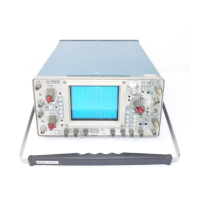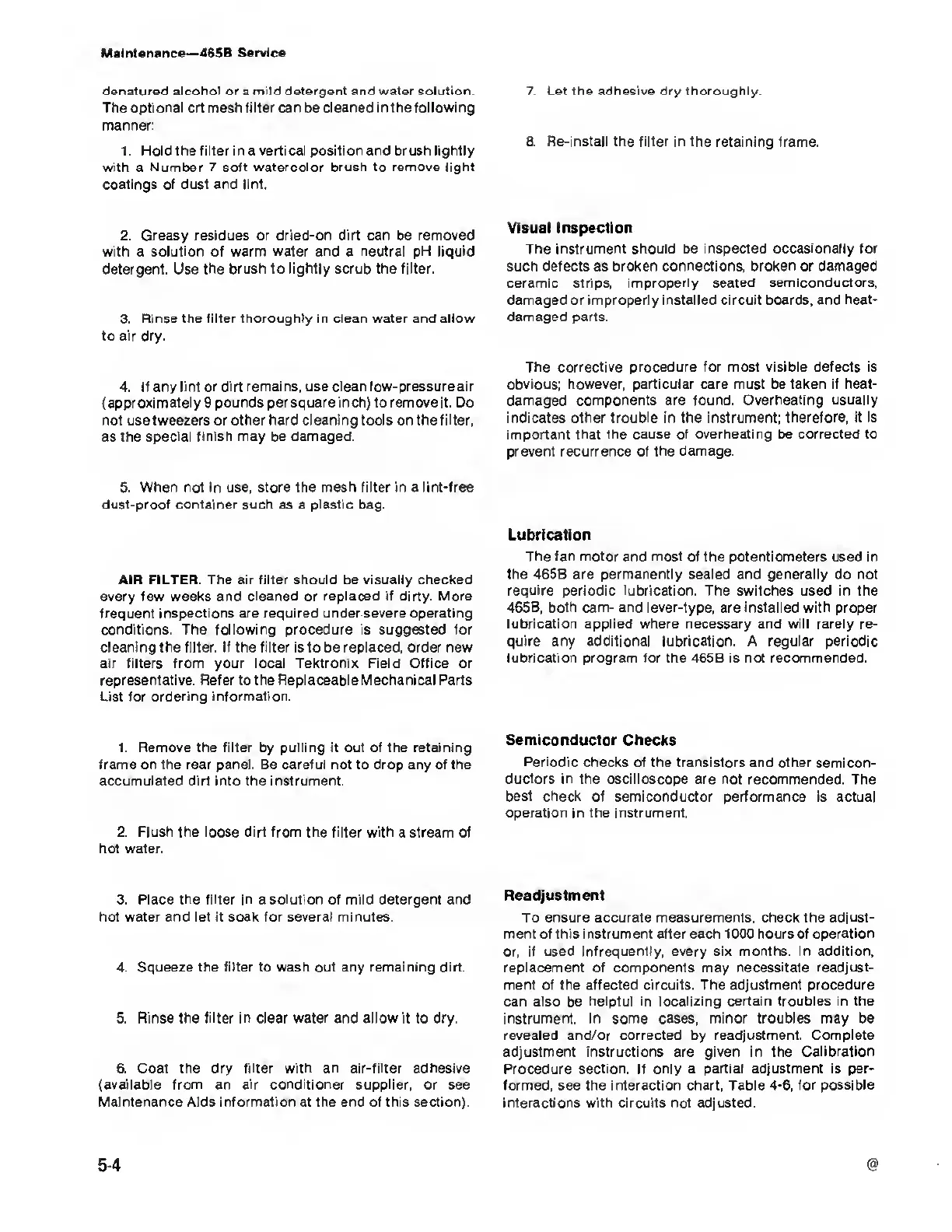Maintenance—465B
Service
denatured
alcohol or
a
mild detergent
and
water solution
The optional crt mesh
filter can
be
cleaned inthefollowing
manner:
1.
Hold
the
filter
in a
vertical position and brush lightly
with a Number 7 soft watercolor brush to remove light
coatings of dust and lint.
2. Greasy residues or
dried-on dirt can be removed
with a
solution
of
warm water and a neutral pH liquid
detergent. Use
the brush
to
lightly scrub the filter.
3. Rinse the filter
thoroughly
in clean water and
allow
to air
dry.
4. If any lint or dirt
remains,
use
clean
low-pressureair
(approximately
9
pounds per
square
inch)
to
remove
it.
Do
not
use tweezers
or other hard cleaning tools on the filter,
as the special finish may be damaged.
5. When not in use, store the mesh filter in a lint-free
dust-proof container
such
as a
plastic
bag.
AIR FILTER. The air filter should
be
visually checked
every few weeks and
cleaned
or
replaced
if dirty. More
frequent
inspections
are required under severe operating
conditions. The
following
procedure is suggested
for
cleaning the filter. If the filter is to be replaced, order new
air filters from your
local Tektronix Field Office
or
representative.
Refer
to
the Replaceable Mechanical Parts
List for ordering information.
1.
Remove the filter
by
pulling it
out of the
retaining
frame on the rear panel. Be careful not
to
drop
any of
the
accumulated
dirt into
the
instrument.
2. Flush the
loose
dirt from the
filter
with a stream of
hot water.
3. Place the filter in a solution of mild detergent and
hot water and let it soak for several minutes.
4. Squeeze the filter to wash out
any remaining
dirt.
5. Rinse the filter in clear water and allow it to dry.
6. Coat the dry filter with an air-filter adhesive
(available from an air conditioner supplier, or see
Maintenance Aids information
at
the end of this section).
7
Let
the adhesive dry thoroughly
8. Re-install the filter
in
the retaining frame.
Visual Inspection
The
instrument should be inspected occasionally for
such defects as broken connections, broken or damaged
ceramic strips, improperly seated semiconductors,
damaged or improperly
installed circuit boards, and heat-
damaged parts.
The corrective procedure for most
visible defects is
obvious; however,
particular
care
must
be
taken
if
heat-
damaged
components are found. Overheating usually
indicates other trouble in the instrument;
therefore,
it
is
important that the cause
of overheating
be
corrected to
prevent recurrence of the damage.
Lubrication
The fan motor and most of the potentiometers used in
the 465B are permanently sealed
and
generally
do not
require periodic lubrication. The switches used in the
465B, both cam-
and
lever-type, are installed with proper
lubrication
applied
where
necessary and will rarely re-
quire any additional lubrication. A regular periodic
lubrication program for the 465B is not recommended.
Semiconductor Checks
Periodic
checks of the transistors and
other semicon-
ductors in the oscilloscope
are not recommended. The
best
check
of semiconductor performance
is actual
operation in the
instrument.
Readjustment
To
ensure accurate measurements, check the adjust-
ment of this instrument after each 1000 hours of operation
or, if used
infrequently,
every six
months.
In
addition,
replacement of components may necessitate readjust-
ment
of
the affected circuits. The adjustment procedure
can also be helpful in localizing certain troubles in the
instrument. In some cases, minor troubles may be
revealed and/or corrected by
readjustment. Complete
adjustment instructions are given in the Calibration
Procedure
section.
If
only
a
partial
adjustment is per-
formed, see the interaction chart, Table 4-6, for possible
interactions
with circuits not adjusted.

